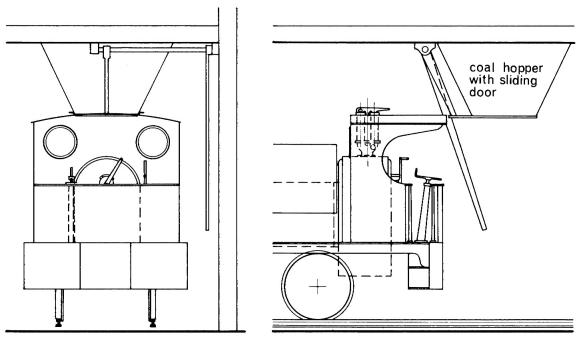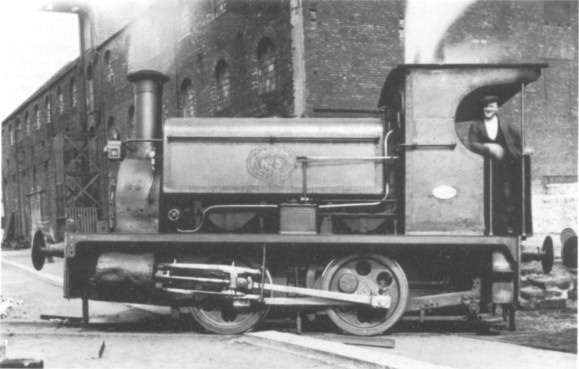
| THE INDUSTRIAL RAILWAY RECORD |
© OCTOBER 1973 |
EXPLOSION AT CADDIR
On Tuesday, 23rd March 1909, at 5.45pm, there was an explosion from a stop-valve chest on a locomotive boiler at No.17 Pit, Caddir, Bishopbriggs, near Glasgow. "The locomotive upon which the explosion occurred was built by Messrs. Manning, Wardle & Company Limited, Hunslet, Leeds, in 1890. A new boiler was supplied by the same firm in 1902, and was fitted in place by the staff of Messrs. The Carron Company at Carron Ironworks, Carron, Falkirk. The locomotive is of the ordinary type employed in shunting operations, and has cylinders 14 inches in diameter, by 18 inches stroke, with a working pressure of 120 lbs. per square inch. ... The Carron Company, besides possessing extensive ironworks, and other commercial undertakings, are the proprietors of a number of coal and ironstone pits, and this locomotive, which is distinguished in their records by the number '5 A,' was engaged in shunting operations between two of these pits, numbers '15' and '17' respectively.
"The small brass stop-valve chest... which is used to regulate the supply of steam for working the feed injectors of the locomotive... suddenly fractured at the neck of the screwed spigot by means of which it was attached to the safety-valve chest... The explosion occurred while the locomotive was approaching, rear-first, the overhead hoppers of the coal-washing plant at No.17 pit. On getting close to the hopper, the driver had shut off the regulator valve, and was standing facing the direction in which the locomotive was moving, with his back to the boiler, ready to apply the brake, when he heard a report behind him, which he describes as resembling the sound of a gauge-glass bursting. On turning round to shut off, as he thought, the water column cocks, he received a blast of steam which severely scalded him... [He] either jumped or fell from the footplate, without applying the brake, and owing to the locomotive continuing in motion, the roof of the cab, through which the safety-valve towers projected, was brought into violent collision with the overhead coal hopper, thus communicating a shock sufficiently violent to fracture the cast-iron safety-valve chest at the neck, causing thereby a much more serious escape of steam.

We are told in the Report that "the roof of the cab of the locomotive is 2 inches higher above the rails than the bottom of the coal hoppers" and although not specifically mentioned the method of working must, of course, have been for the engine to stop short of the hopper, pulling the wagons out again after loading. The above diagram is reproduced from a similar one in the report.

The locomotive concerned in the boiler explosion was Manning Wardle 1183 of 1890, seen here as CARRON No.5 on 4th July 1936. (G. Alliez)
"There is no doubt that the driver, blinded and stupefied by the explosion, in either jumping or falling from the footplate, providentially saved his life, as the fracture of the safety-valve chest, in such a situation, would, with almost any useful pressure of steam, have meant certain death for him. Having regard to the diameter of the spigot of the stopvalve chest, the thickness of the metal at the line of rupture was fairly substantial, and it would seem that the metal must have deteriorated or become damaged, probably by overstraining, before it would suddenly give way as stated in the report. ... The circumstances attending this case clearly show the necessity of great care being exercised in the fitting of mountings to boilers, as the slightest want of care may subsequently lead to serious results."
(Information extracted from Boiler Explosion Report No.1843, issued by the Board of Trade Surveyors' Office, Glasgow.)
"Last Saturday afternoon a railway block occurred at Maryville station, near Uddingston, on the North British Railway, causing considerable detention to passenger and mineral traffic. A pug engine belonging to one of the Clydeside Collieries had been shunting some wagons in the vicinity of Maryville station, when, owing to some unexplained circumstance, it ran through the points and went off the rails, completely blocking the line. The two o'clock passenger train .. was detained for over an hour."
("The Railway Herald," 2nd July 1898. — WACS)
Tenders invited 'for laying 500 yards of Permanent Way for the Redheugh Colliery Siding, to join Team Valley Railway Colliery Office, Gateshead.' ("Iron" 1st January 1876. — KPP)